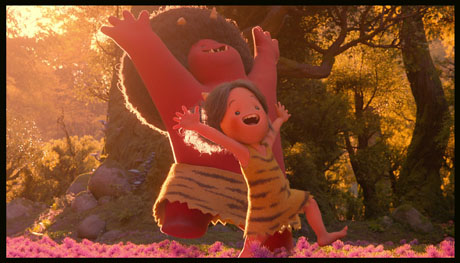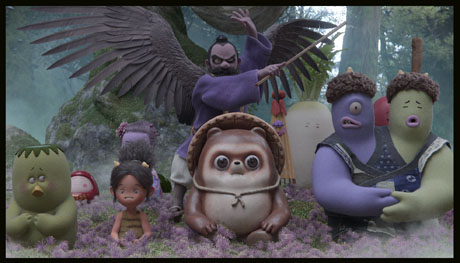
From Tonko House, the makers of bold, Oscar-nominated short “The Dam Keeper”, comes a new four-part series debuting October 21st on Netflix. Oni: Thunder God’s Tale introduces us to Onari, a curious and courageous girl, daughter and friend. She seeks the powers that can help defeat the evil Oni, on their way to possibly destroy her village. But along the way, Onari will learn so much about herself and others — and discover what it truly means to be a hero. I spoke with creator Daisuke ‘Dice’ Tsutsumi and executive producers Robert Kondo and Sara K. Sampson. (This Animation Scoop Q&A was edited for length and clarity.)
Jackson Murphy: Dice, what do you think makes Onari such a compelling lead character? I really think she is.
Daisuke ‘Dice’ Tsutsumi: (laughs) That’s great. That’s an amazing question, and I want to answer it right. The concept of Oni comes from the famous villain character from Japanese folklore. There’s this interesting historical theory about Oni potentially being the description of a foreigner or Indigenous people who didn’t look like Japanese locals back in the day. I really felt that concept was so interesting because we still carry that same human nature — that we’re afraid of people we don’t understand or things or cultures we don’t know. That story of finding who you are and being honest about who you want to be vs. who you truly are… The struggle is something, I believe, that everybody can relate to. I certainly have… living in the United States for 30 years as a foreigner. Onari was a very personal expression of my story. However, I think it became so compelling because a lot of us who worked on this project, including Sara and Robert, and also our writer Mari [Okada], brought their own Onari into the character.

JM: And Robert, the central father-daughter relationship here is very strong. What were some of the challenges and opportunities you had with this aspect?

Robert Kondo
JM: Yes, a lot of parents and uncles and aunts will find many sections moving. And Sara, we have this impending threat. And through some of the scenes in the first two episodes, you’re able to show child AND adult perspectives of what’s going to happen. What do you find so fascinating about the different perspectives of what could be coming?
Sara K. Sampson: I love that the children are actually the ones teaching us something here. (laughs) It’s so easy to default into a black and white, blanket state of ‘the evil Oni are coming’. But I feel like in “Oni”, the children are the most curious. They want to find out what is really happening, and that’s why I love Onari’s journey so much. She teaches us to look beyond what’s in front of us. Go Onari!

JM: And Dice, right from the get-go, I love how you play with light and dark — light within the darkness / darkness within the light. What do you love so much about that?
DT: Ever since Robert and I started working together to write our own stories, the light and dark… within humanity… has been our theme at Tonko House. The Dam Keeper, Moom and Pig: The Dam Keeper Poems always dealt with darkness and light within our characters. “Oni” is no different, especially once you get into Chapters 3 and 4. It’s all about the light and darkness that live within each one of us. It’s not about evil character. It’s about something you find within yourself. The expression of it using light, visually, is so important for us to tell that story. I was the lighting art director at Pixar before we started Tonko House, so light is something I love to use as a tool to tell a story.
JM: It’s fantastic. Robert, how did you use nature as an inspiration? There are so many gorgeous outdoor moments. Did you go to places?
RK: To be honest, I would’ve loved to go to someplace, but Dice and Mari went to this beautiful forest called Yakushima in the south of Japan. It’s the oldest Growth forest in Japan, and it’s got wonderful layers of moss and vegetation and trees that are knotted and twisted. They look like they’ve been there forever. We have this idea of a forest, and you don’t immediately think of a forest as a place where kids should run free and play. So we had to take that idea — the richness that Dice really loved… the feeling of that forest that he loved and try to find a way to capture that in CG while making it this playful neighborhood, almost, for these Kami to grow up.
A lot of this was achieved working with our CG partners Megalis, who really found a technical way to populate this forest, create these sculptural trees procedurally and then layer them with all sorts of moss, mushrooms and plants. At that point it’s a bit like a kid playing with a playset where you’re sculpting it and creating these little pockets that end-up on screen and are achieving through the lighting (that Dice was talking about) really specific story moments… and trying to be precise in capturing the forest but also a fantasy and the fun of the story.

Sara K. Sampson
SS: Oh man. Just reading comments from the trailer, it’s so exciting to us to get some external feedback for the first time. We’ve been working on “Oni” for the last two years now. A lot of people still think it’s stop-motion, which is a huge compliment to us. Stop-motion has always been our inspiration. We worked hard to capture very strong poses and very tactile feelings of our characters to create that extra depth. I hope it inspires future animation like this. It was so fun to make.
JM: It will be inspiring. And Dice, one of the themes of this show is listening to your inner voice. How did you find that in making “Oni”? Was there a specific moment where you felt like you needed to listen to your inner voice?

Dice Tsutsumi
Eventually, while our main character struggles to find herself in this journey, the love… and the relationship between Naridon and Onari became a huge anchor in the end. That’s what ended-up being a huge win for us. I’m personally saying, ‘my mom must’ve really helped me to find it,’ Of course, everybody had a different inspiration during the journey. But for me, that was a huge inspiration.

JM: I’m sorry for your loss, but I’m so glad your mother served as an inspiration for this and that she cared so much about what you did and that you cared so much about her. Robert, what do you think makes a good hero in animation storytelling?
RK: In truth, I think it really is about flaws that are relatable. Heroes that we can empathize with — and relate to. Right from the get-go, Onari is somebody that has huge dreams. These characters are us on some level. These stories serve a lot of purposes, not just as entertainment but that artistic voice is a voice of expression. It’s a part of our own way of dealing with the world that we all live in. That’s why it’s so important to create heroes that are flawed because that’s human nature. Having big dreams and aspiring for something even greater than yourself is a worthwhile, lifelong pursuit. And that’s also what our studio’s about. All of it is embodied in this little character these guys created.
JM: And Sara, what do you think is this show’s true power?
SS: True power is love. I know that may sound cliché, but I echo Robert’s sentiments. This journey of Onari opening her heart and mind to find something bigger than yourself is the lasting message people will discover between Onari and her dad, Naridon.
- INTERVIEW: Jeff Fowler On “Knuckles” And “Sonic 3” - April 22, 2024
- INTERVIEW: “Inside Out 2” Director And Producer On Pixar Sequel - April 16, 2024
- INTERVIEW: “Puffin Rock And The New Friends” And 25 Years Of Cartoon Saloon - April 10, 2024


 October 20th, 2022
October 20th, 2022  Jackson Murphy
Jackson Murphy  Posted in
Posted in  Tags:
Tags: 






